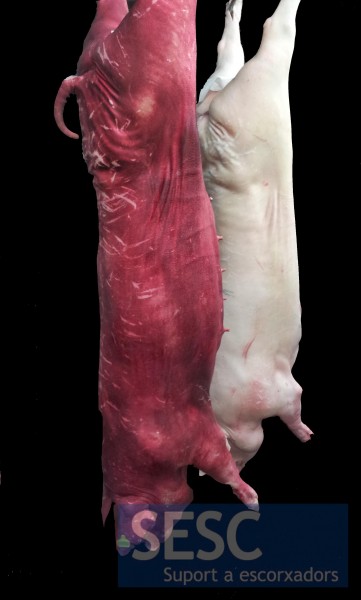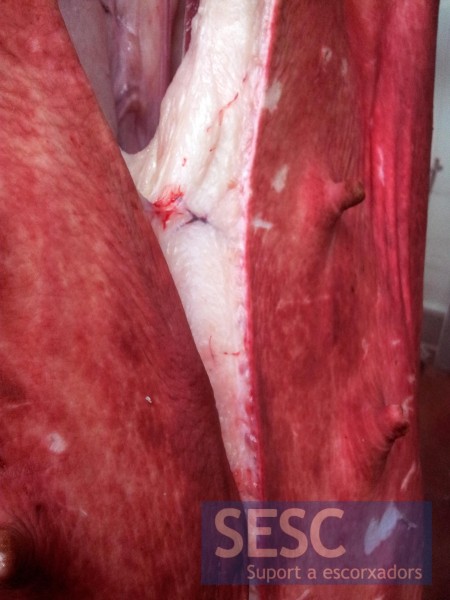El curiós cas del porc vermell
L’estudi histopatològic de la pell no permet arribar a cap diagnòstic morfològic degut als artefactes que l’escaldat provoca en la pell (despreniment de l’epidermis i coagulació de la dermis superficial). A nivell de la dermis profunda s’observa una congestió marcada dels capil·lars sanguinis amb presència de fenòmens de marginació leucocitària (polimorfonuclears neutròfils adherits a la paret dels capil·lars).
Es tracta doncs d'un eritema generalitzat (degut a una congestió capil·lar) de causa desconeguda. Entre les possibilitats que s'han discutit s'inclouen alteracions per agents químics o físics. En principi podem descartar també altres malalties que donen quadres eritematosos però amb lesions de tipus hemorràgic o necròtic com el mal roig, SDNP o pesta porquina.
Malauradament no disposem d’informació sobre l'aspecte antemortem de l'animal, i per tant, no podem descartar (ni confirmar) una alteració prèvia al sacrifici. L’alteració només va afectar un porc de tot el lot.
Si algú s’ha trobat amb casos similars o te una idea de què pot causar aquest tipus de lesió el/la convidem a compartir-ho a la secció de comentaris que hi ha al final d’aquesta entrada.




13 comment(s)
Yo apostaría que entró al escaldado vivo.
La neumonía por aspiración de agua de escaldado y la presencia de sangre en ventrículo izquierdo confirmaría que no fue sangrado.
El enrojecimiento puede deberse al ingreso del cerdo vivo a la tina de escaldado; ingreso de cerdo a la peladora sin ducha constante; en ambos casos se presenta la piel roja
Aquí hemos recogido otras opciones:
https://sesc.cat/cinc-raons-que-poden-fer-que-una-canal-porc-es-torni-vermella/?lang=es
Comment from European Animal Health Professionals group in LinkedIn:
By Gustavo Ródenas Cecilia
Veterinarian. Master’s degree in Medicine, Animal Health and Animal breeding
Good evening, in my opinion the most likely cause is that this is a case of Porcine Dermatitis and Nephropathy Syndrome. I do not believe that this has been caused by the scalding process as the color you get in overscald carcases is more like a pale cooked appearance, with the skin cracked and partially detached. The scratches on the back are the typical marks of fights, nothing to deal with an overscald process in my opinion. Other comments point that this can be caused by a poor bleeding, but in that case I believe that a generalized congestion of the carcases (not only on the surface) would be observed. In addition the red color would not be uniform in the carcass but focused in the lower areas.
Translation of the previous comment from Mr. Llopart:
I found these lesions when the scalding unit crashes and the animal is stuck with the blades that circulate the carcasses inside the scalding unit.
The marks, fairly deep scratches, on the carcass surface can be observed.
The time that the carcass has been dipped in at 63 °C must be assessed, if it is longer than 20 minutes and, when gutted, the viscera and meat appear whitish, exudative and with a fecal odor the carcass must be condemned.
The companies do not have adequate size machinery to sacrifice animals of a certain size but still sometimes use the scalding units for normal pigs.
He trobat aquestes lesions quan s’ha espatllat la màquina de escaldar i el animal queda enganxat amb les pales que fan circular els animals per dintre la màquina.
Es poden veure les marques externes a la canal ,ratllades bastant profundes.
Cal valorar l’estona que ha estat sumergit a 63ºC, si és més de 20 min i al eviscerar-lo es veuen les visceres i la carn blanquinoses ,exudatives i amb una olor fecal, és decomís total.
Les empreses no tenen maquinària adient per sacrificar animals tan grossos i els posen a les escaldadores de porcs normals .
Comment from Swine Health, Nutrition and Production Professionals group in Linkedin:
Jørgen Lindahl
Överveterinär at Distriktsveterinärerna
To me it looks like the animal not were bleeded correct and for that reason maybe even was alive when it was scalded? Water from scalding in the lungs could indicate that it is the reason?
Comment from Livestock Health: International information portal for veterinarians group in Linkedin:
Ana Isabel Perez Lázaro
Food safety, Quality assurance, Quality management
I have seen some chickens showing this aspect due to an insufficient bleeding caused by an inadequate killing and going into the scalding tank before the bleeding was completed. Very strange that this happens in a pig but everything is possible!
Comment from Livestock Health: International information portal for veterinarians group in Linkedin:
Jessica Gaudy
Senior Research Technician at University of Warwick
Oh heavens, I don’t recall seeing anything like that before. I don’t suppose they collected any blood samples? It would be interesting to see what was going on within the blood, if there were any cellular or fluid abnormalities.
Comment from Swine Health, Nutrition and Production Professionals group in Linkedin:
Ronald Torregoza
Farm Veterinarian at Marcela Farms, Inc.
I have seen a lot of PDNS cases and it does not look like one. In my honest opinion, the closest thing that I can think of is that the animal was probably scalded while still alive which may explain the generalized erythema. Other than that I doubt that the animal looks like that before slaughter, otherwise it will not pass through premortem inspection since it would have been to obvious that the animal has a generalized skin condition.
Por qué no mal rojo? Tras superar la enfermedad?
A mi parecer, ese cerdo ha permanecido en la balsa de escaldado durante un tiempo excesivamente prolongado..
Interesante caso, nunca habia visto algo parecido!